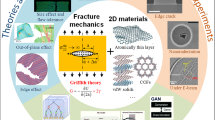Abstract
In this work, we propose to succinctly review, in non technical terms, the current mathematical state of brittle fracture first put forth by A. A. Griffith in his seminal work Griffith (Philos Trans R Soc Lond CCXXI-A:163–198, 1920), then re-interpreted under the label “variational fracture” in Francfort and Marigo (J. Mech Phys Solids 46(8):1319–1342, 1998). and subsequent works. We will only address the sharp theory and will limit ourselves to a theoretical exposition, leaving phase-field approximations and other possible implementations to other articles within this volume.


Similar content being viewed by others
Notes
Our admittedly personal account of that story will keep the number of references to a minimum. Narrative continuity is our goal, not taxonomy. Nor for that matter exhaustion: many topics worthy of investigation will not even get a mention, be it non-interpenetration, dynamics, energy dissipating evolutions, ....
We find telltale signs in the work of J. Rice (see e.g. (Rice 1979, Sect. 3) but have been at pains to isolate a definitive statement of its origin in the literature.
Irreversibility may be debatable when dealing with elastomers or gels.
The symbol \(_\lfloor \) means “restricted to”.
Although quite natural, this assumption prohibits jumps on \(\partial _d\Omega \) so that a tearing experiment with \(u=d\) on one side of a pre-crack and \(u=-d\) on the other side is not allowed.
It may be so that the physics underlying proper phase-field models is actually a better fit for brittle fracture than the sharp theory. As already stated, ours is only a Griffith universe beyond which we dare not venture for fear of getting sucked into a modeling wormhole.
This will not produce an exact solution, because that solution will exhibit a discontinuity of the normal stress at the points \((\ell (t),y), \; y\ne 0\).
To our knowledge one has to appeal to results in Grisvard (1985) which deal exclusively with polygonal domains.
Actually the result is more general and does not allow cracks whose length is asymptotically like that of a line segment as that length tends to 0. Also the assumption that the pre-crack is straight can be greatly relaxed (see Babadjian et al 2015)
References
Ambrosio L (1990) Existence theory for a new class of variational problems. Arch Ration Mech Anal 111:291–322
Ambrosio L, Fusco N, Pallara D (2000) Functions of bounded variation and free discontinuity problems. Oxford University Press, Oxford
Babadjian J-F, Chambolle A, Lemenant A (2015) Energy release rate for non-smooth cracks in planar elasticity. J Éc Polytech Math 2:117–152
Babadjian JF, Giacomini A (2014) Existence of strong solutions for quasi-static evolution in brittle fracture. Ann Sci Norm Super Pisa Cl Sci 13(4):925–974
Ball JM (1976) Convexity conditions and existence theorems in nonlinear elasticity. Arch Rational Mech Anal 63(4):337–403
Bonacini M, Conti S, Iurlano F (2020) Cohesive fracture in 1D: quasi-static evolution and derivation from static phase-field models. Arch Ration Mech Anal. https://doi.org/10.1007/s00205-020-01597-1
Bouchitté G, Braides A, Buttazzo G (1995) Relaxation results for some free discontinuity problems. J Reine Angew Math 458:1–18
Bourdin B, Francfort GA, Marigo J-J (2008) The variational approach to fracture. Springer, New York. Reprinted from J. Elasticity 91 (2008), no. 1–3 [MR2390547], With a foreword by Roger Fosdick
Chambolle A, Crismale V (2019) Existence of strong solutions to the Dirichlet problem for the Griffith energy. Calc Var Partial Differ Equ 58(4):136
Chambolle A, Francfort GA, Marigo J-J (2010) Revisiting energy release rates in brittle fracture. J Nonlinear Sci 20(4):395–424
Chambolle A, Giacomini A, Ponsiglione M (2008) Crack initiation in brittle materials. Arch Ration Mech Anal 188(2):309–349
Dal Maso G, Francfort GA, Toader R (2005) Quasistatic crack growth in nonlinear elasticity. Arch Ration Mech Ann 176(2):165–225
Dal Maso G, Giacomini A, Ponsiglione M (2009) A variational model for quasistatic crack growth in nonlinear elasticity: some qualitative properties of the solutions. Boll Unione Mat Ital (9) 2(2):371–390
Dal Maso G, Lazzaroni G (2010) Quasistatic crack growth in finite elasticity with non-interpenetration. Ann Inst H Poincaré Anal Non Linéaire 27(1):257–290
Dal Maso G, Toader R (2002) A model for the quasi-static growth of brittle fractures: existence and approximation results. Arch Ration Mech Anal 162:101–135
De Giorgi E, Carriero M, Leaci A (1989) Existence theorem for a minimum problem with free discontinuity set. Arch Ration Mech Anal 108:195–218
Dumas A (1854) Un cas de rupture
Francfort GA, Larsen CJ (2003) Existence and convergence for quasi-static evolution in brittle fracture. Commun Pure Appl Math 56(10):1465–1500
Francfort GA, Marigo J-J (1998) Revisiting brittle fracture as an energy minimization problem. J Mech Phys Solids 46(8):1319–1342
Friedrich M, Solombrino F (2018) Quasistatic crack growth in 2d-linearized elasticity. Ann Inst H Poincaré Anal Non Linéaire 35(1):27–64
Griffith AA (1920) The phenomena of rupture and flow in solids. Philos Trans R Soc Lond CCXXI–A:163–198
Grisvard P (1985) Elliptic problems in non smooth domains. Monographs and Studies in Mathematics, vol 24. Pitman, London
Kumar A, Bourdin B, Francfort GA, Lopez-Pamies O (2020) Revisiting nucleation in the phase-field approach to brittle fracture. J Mech Phys Solids 142:104027
Larsen CJ (2010) Epsilon-stable quasi-static brittle fracture evolution. Commun Pure Appl Math 63(5):630–654
Leblond J-B (1989) Crack paths in plane situation—I, General form of the expansion of the stress intensity factors. Int J Solids Struct 25:1311–1325
Mumford D, Shah J (1989) Optimal approximations by piecewise smooth functions and associated variational problems. Commun Pure Appl Math XLII:577–685
Rice JR (1979) The mechanics of quasi-static crack growth. In Kelly RE (ed) Proceedings of the Eighth U.S. National Congress of Applied Mechanics. Western. Periodicals Co, North Hollywood, pp 191–216
Author information
Authors and Affiliations
Corresponding author
Additional information
Publisher's Note
Springer Nature remains neutral with regard to jurisdictional claims in published maps and institutional affiliations.
The author wishes to acknowledge A. Dumas (fils) who thoroughly investigated a case of rupture in Dumas (1854), this some seventy years before A.A. Griffith.
Rights and permissions
About this article
Cite this article
Francfort, G.A. Variational fracture: twenty years after. Int J Fract 237, 3–13 (2022). https://doi.org/10.1007/s10704-020-00508-5
Received:
Accepted:
Published:
Issue Date:
DOI: https://doi.org/10.1007/s10704-020-00508-5




